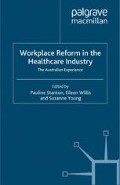Abstract
There is currently a major shortage of working nurses in Australia. It is expected that this shortage will worsen in the immediate future (AIHW, 2003; Buchanan and Considine, 2002; DEST, 2002). A recent government report indicates a shortfall of 31,000 nurses by 2006 (DEST, 2002). This skilled labour shortage is not confined to Australia and is an international problem (Loquist, 2002). Countries such as the UK and the USA have experienced long-term problems in nursing labour supply and have relied extensively on immigration to supplement local labour shortages (Davis and Nichols, 2002).
We would like to thank the nurses who participated in our study. We would also like to acknowledge the assistance and support of our colleagues, Andrea Fox, Chris Houghton, David Peetz and Bob Russell. This project was funded bv an Australian Research Council Linkage Grant.
Access this chapter
Tax calculation will be finalised at checkout
Purchases are for personal use only
Preview
Unable to display preview. Download preview PDF.
References
ABS (Australia Bureau of Statistics) (2003) Private Hospitals Australia, Cat. No. 4390.0 (Canberra).
AIHW (Australian Institute of Health and Welfare) (2003) Nursing Labour Force 2001, AIHW Cat. No. HWL 26 (Canberra).
AIHW (Australian Institute of Health and Welfare) (2004) Australia’s Health 2004, AIHW Cat. No. AUS 25 (Melbourne).
Allan, C. (2000) ‘The Hidden Organisational Costs of Using Non-Standard Employment’ Personnel Review, 29(2), pp. 188–206.
Allan, C. (1998) ‘The Elasticity of Endurance: Work Intensification and Workplace Flexibility in the Queensland Public Hospital System’ New Zealand Journal of Industrial Relations, 23(3), pp. 133–151
Allan, C. (1996) Labour Utilisation in Queensland Hospital, Unpublished PhD thesis (Faculty of Commerce and Administration, Griffith University).
Allan, C. and Barry, M. (1999) ‘The Private Hospitals’ Association of Queensland’ in P. Sheldon and L. Thornthwaite (eds) Catalysts and Captives: Employer Associations and Industrial Relations Change in Australia (Sydney: Allen and Unwin) pp. 159–166.
Armstrong, F. (2001) ‘Addressing Workforce Issues: Federal Election 2001’ Australian Nursing Journal, 9(1), pp. 28–31.
Armstrong, F. (2003) ‘Migration of Nurses: Find a Sustainable Solution’ Australian Nursing Journal, 11(3), pp. 25–6.
Buchanan, J. and Considine, G. (2002) ‘Stop Telling us to Cope!’: NSW Nurses Explain Why they are leaving the Profession (Sydney: ACCIRT, University of Sydney).
Davis, C. and Nichols, B. (2002) ‘Foreign-Educated Nurses and the Changing U.S. Nursing Workforce’ Nursing Administration Quarterly, 26(2), pp. 43–51.
DEST (Department of Education, Science and Training) (2002) National Review of Nursing Education (Canberra).
Fleming, K., Evans, J. and Chutka, R. (2003) ‘Caregiver and Clinician Shortages in an Ageing Nation’ Mayo Clinic Proceedings, 78(8), pp. 1026–41.
Guest, R. and McDonald I. (2000) ‘Population Ageing and Projections of Government Social Outlays in Australia’ The Australian Economic Review, 33(1), pp. 49–64.
Hall, J. (2001) The Public View of Private Health Insurance (Sydney: The Australian Health Policy Institute, University of Sydney).
Loquist, R. (2002) ‘State Boards of Nursing Respond to the Nurse Shortage’ Nursing Administration Quarterly, 26(4), pp. 33–9.
Lumley, C. (2001) ‘Casualisation in Nursing: Friend or Foe?’ Unpublished Master’s Thesis (School of Public Health, La Trobe University).
Lumley, C. (2004) ‘Casualisation Friend or Foe? A Case Study Investigation of Two Australian Hospitals’ New Zealand Employee Relations Journal, 29(2), pp. 33–49.
Morehead, A. (2003) ‘Managing Flexible Working Time Arrangements: Negotiations between Mothers and Managers in a Canberra Hospital’ Labour and Industry, 14(1), pp. 91–106.
Nursing and Health Services Research Consortium (2000) NSW Nursing Workforce Research Project (Sydney: Nursing and Health Service Research Consortium).
Pocock, B. (2003) The Work/Life Collision (Annandale: Federation Press).
Queensland Nurses’ Union (2004) ‘The Nursing Perspective’ Work, Time and Life Conference. http://www.qnu.org.au/worktimelife.htm.
Randolph, L. (2003) ‘Why consider travel nurses?’ Nursing Management, 34, pp.4–5.
Shullanberger, G. (2000) ‘Nurse Staffing Decisions: An Integrative Review of the Literature’ Nursing Economics, 18(3), pp. 124–48.
Smith, A. (2003) ‘Nurses under your Nose: The Chicago-Mexico Nurse Initiative’ Nursing Economics, 21(4), pp. 176–87.
Victorian Government Department of Human Services (2001) The Nurse Recruitment and Retention Committee Final Report (Melbourne).
Watson, I., Buchanan, J., Campbell, I. and Briggs C. (2003) Fragmented Futures: New Challenges in Working Life (Sydney: The Federation Press).
Watson, J. (2001) ‘Post-Hospital Nursing: Shortage, Shifts and Scripts’ Nursing Administration Quarterly, 25(3), pp. 77–82.
Weekes, K., Peterson, C., and Stanton, P. (2001) ‘Stress and the Workplace: The Medical Scientist’s Experience’ Labour and Industry, 11(3), pp. 95–120.
White, N. and Bray, M. (2003) ‘The Changing Role of Nursing Unit Managers: A Case of Work Intensification?’ Labour and Industry, 14(2), pp. 1–20.
Willis, E. (2002) ‘Enterprise Bargaining and Work Intensification: An Atypical Case Study from the South Australian Public Hospital Sector’ New Zealand Journal of Industrial Relations, 27(2), pp. 221–32.
Editor information
Editors and Affiliations
Copyright information
© 2005 Contributors
About this chapter
Cite this chapter
Townsend, K., Allan, C. (2005). Flexibility at a Cost: Responding to a Skilled Labour Shortage. In: Stanton, P., Willis, E., Young, S. (eds) Workplace Reform in the Healthcare Industry. Palgrave Macmillan, London. https://doi.org/10.1057/9780230596009_10
Download citation
DOI: https://doi.org/10.1057/9780230596009_10
Publisher Name: Palgrave Macmillan, London
Print ISBN: 978-1-349-51808-1
Online ISBN: 978-0-230-59600-9
eBook Packages: Palgrave Business & Management CollectionBusiness and Management (R0)

